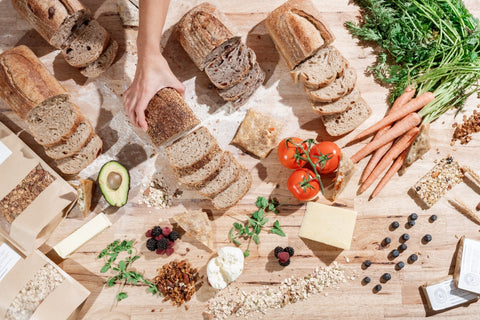Bread exists in many varieties, like sourdough, sweet bread, soda bread, etc. It may be served in different forms at any meal of the day, eaten as a snack and is even used as an ingredient in other culinary preparations.
Eating grain foods, like bread, plays an essential role in your diet by providing many nutrients, such as dietary fiber, vitamins, and minerals, that are vital for the health and maintenance of our bodies.
In our previous blog, we explained the difference between organic and non-organic food.
It’s just as important to eat organic bread as it is any other natural food in your diet.

What is the difference between Organic Bread and Fresh Bread?
A given loaf of bread could be both organic and fresh, organic and not fresh, fresh but not organic, or neither fresh nor organic. The term “fresh” has technical definitions (used by government agencies) and commercial definition (used by producers).
Simply said, “fresh” bread means it has been baked recently (usually within a day) and says nothing about what ingredients went into making it, nor anything about the source of those ingredients. It may or may not be organic. Fresh also implies that the bread was never frozen (or canned, irradiated, salted, pickled or otherwise preserved, but those rarely apply to bread). However, producers are always inclined to bend the definitions, and we now have an in-betweener brad, which is called: par-baked or partially baked. These large industrial producers sell this bread to small bakers, grocery stores, cafes, and more, and they only require a 7-10 minute baking time. This bread is unfortunately still allowed to be called fresh, although it becomes dry within 5 hours.
Most people would agree that, with a few exceptions, fresh bread has better flavor and texture than non-fresh bread. Some sourdough loaves of bread do not reach their flavor peak until 24-48 hours after baking.
“Organic” bread, theoretically means that the vast majority of the ingredients which went into making it is sourced from suppliers which meet the USDA (United States Department of Agriculture) definition of “Organically Grown.” To be considered organic, loaves of bread must have ingredients that are grown without the use of pesticides, synthetic fertilizers, sewage sludge, genetically modified organisms (GMO’s), or ionizing radiation.
Organic products have strict production and labeling requirements. Organic bread must meet the following criteria:
Produced without excluded methods (e.g., genetic engineering), ionizing radiation, or sewage sludge. Produced per the National List of Allowed and Prohibited Substances (National List). Overseen by a USDA National Organic Program authorized the certifying agent, following all USDA organic regulations.
The benefits of organic food are numerous. They are produced without harmful pesticides and chemicals, and contain natural, healthy, whole food ingredients that provide vital nutrients to your body!
BREADSIE Bread is made using 100% organic flour, without any accelerators and merely allowing nature to do its magic (naturally leavening), and they’re always baked a few hours before delivery (hence 100% FRESH). We believe that our bread is most magical when it is warm (and evokes feelings), most tasteful 24 to 48 hours after baking, and best bread to toast from day 3 to 7.





Comments (0)
There are no comments for this article. Be the first one to leave a message!